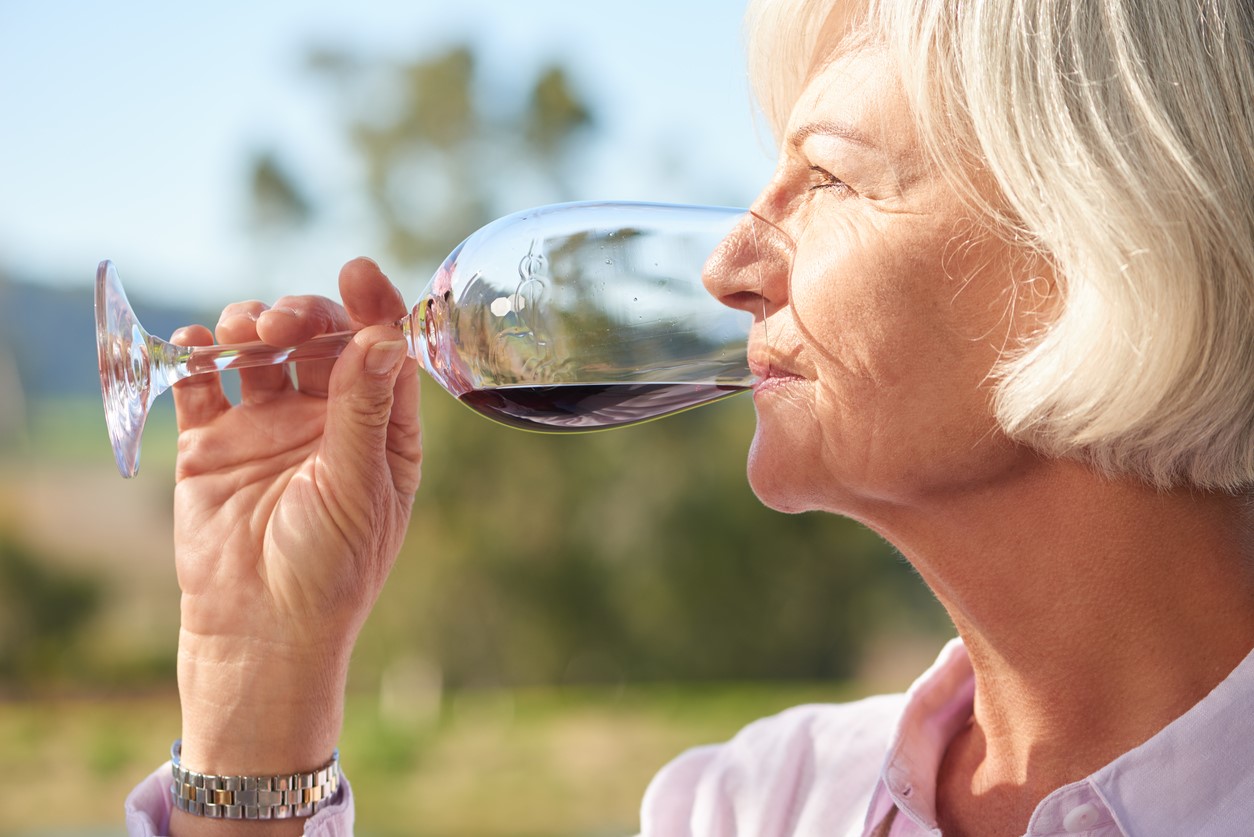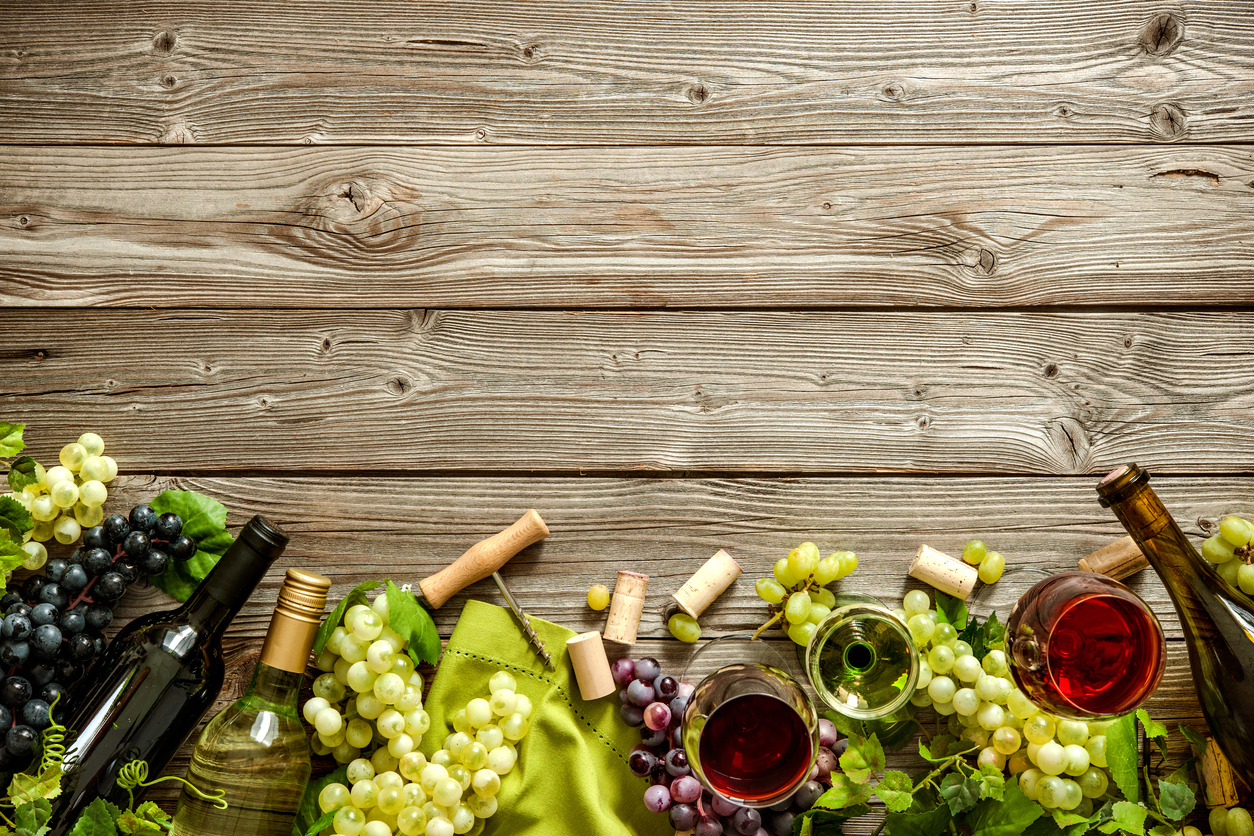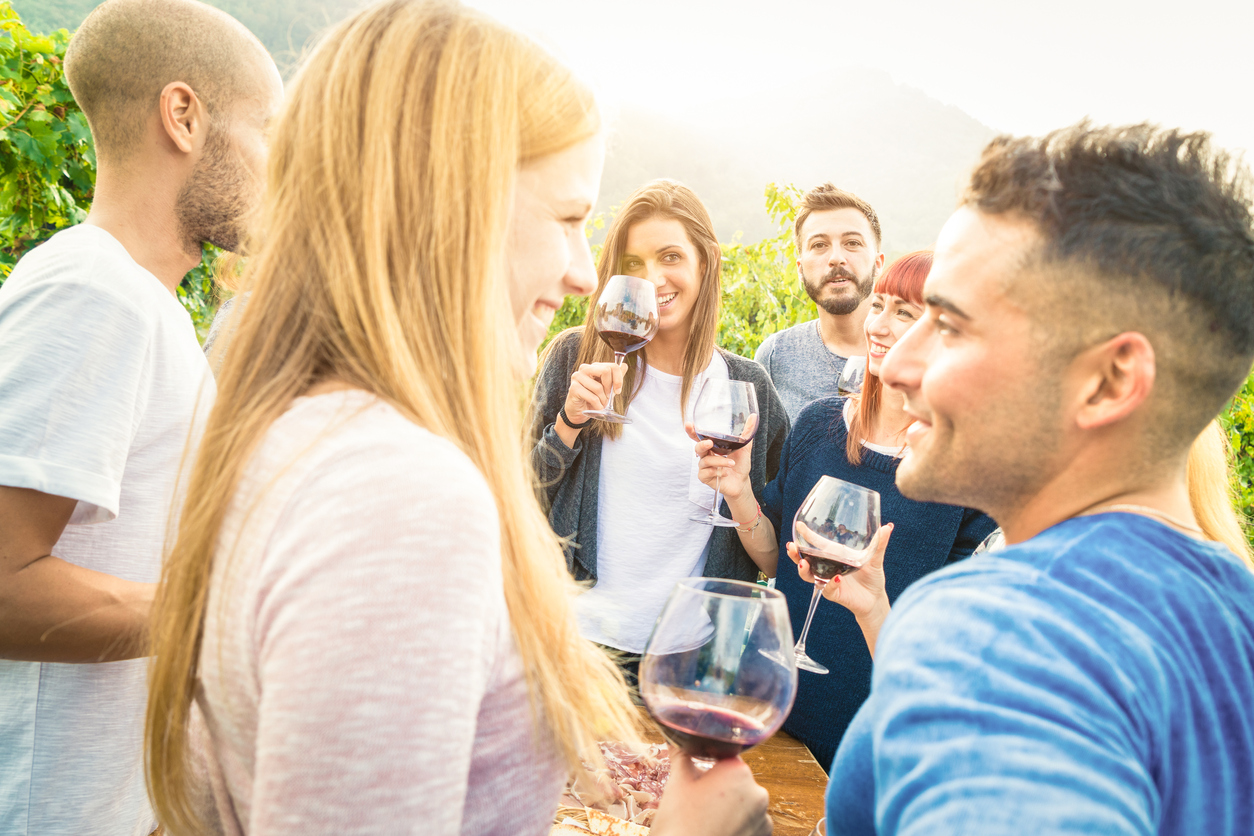Blog
Fruit, Flowers, Oak, and More: The Flavors and Aromas of Orange Coast Wines

Prepare to learn the story of a grape’s journey, told through aromas and flavors.
What do you taste? It’s the penultimate question related to wine. That’s because what you taste is totally dependent on a wine’s aroma. The easily-identifiable fragrances and aromas in wine are due to the grapes being used, which develop their characteristics from the terroir—the soil in which they grow—and finally by the choices made by the winemaker.
We append elements like aroma and flavor as a way to communicate the way wine interacts with us. It’s exciting and gratifying when we identify a singular characteristic in a wine, and those drinking it with us agree: they can taste or smell it, too!
Primary aromas
You’ll experience what’s known as a primary aroma in a young wine. These early scents are mostly identified with fruits. With red wines, you’ll detect:
- Strawberries
- Cherries
- Boysenberry
- Blueberry
- Blackberry
- Cassis
White wines often are associated with primary tastes of:
- Citrus
- Apple
- Pear
- Pineapple, or other tropical fruits
You say you’re tasting a hint of coffee? Or maybe chocolate? You’re detecting the characteristics the wine has pulled in from the oak casks in which it aged. Different wood species will help wine to develop characteristics that can remind you of flowers, or even licorice.
With age, sophistication
Over time, as the wine continues to age in the bottle, it’ll develop what’s known as tertiary qualities. These are the secondary flavors and aromas that’ll come to mind when you take a sip of wine and after you experience the stronger primary flavors and aromas.
They won’t come so easy. Often, they’re subtle. You’ll definitely need your best sense of smell to coax them out. Some of the more easily recognizable ones are:
- Tobacco
- Spice
- Earth
- Smoke
- Stone
These tertiary qualities develop over time, and they add both complexity and depth to a wine. They’re usually associated more with the characteristics of the earth in which the grapes grew. A taste of wine that after a moment makes you think of stones often speaks of soil that sits upon limestone bedrock. It shapes the pH of the soil. The grapes have pulled this in through the soil, and now they’re telling you the story of the ground in which they grew.
Who knew that wine could be such a conversationalist?
What do Orange Coast wines have to say?
The Orange Coast Malbecs and Zinfandels will definitely speak to you of berries. If your preference is for a white wine, you’ll find that the Orange Coast Pinot Grigio has a primary aroma of pears and finishes with a floral flourish. The Sauvignon Blanc, on the other hand, will serve you an aroma of lemon grass and citrus before finishing off with hints of vanilla.
What do you taste? The sensations your nose and mouth deliver to you are pieces of the story of a grape’s journey. You’re experiencing the tale of what it took from the earth as it grew, what it learned from the wood as it fermented, and what it combined to unfold as it aged in a bottle.
The Musicians of Orange Coast Winery
Excellent wine and great music: Is there a better combination?

Though the wine may be the star of the show, there are other reasons to come out to the winery to see us. We regularly host special events, including live music featuring some of the best musicians from the area and all over the country. Here’s just a sample of who you might see when you visit us.
James Intveld
A native of Los Angeles, James Intveld has been performing for decades and has put out three albums. Often compared to the likes of Roy Orbison and Ricky Nelson, Intveld creates his own unique blend of music that encompasses old-fashioned rockabilly with a more modern flare. In addition to music, Intveld has other passions: acting and directing. He’s been in several movies, including Indian Runner and Chrystal, and you didn’t see him in Cry Baby, but you heard him every time Johnny Depp sang. To learn more about James Intveld, you can visit his website, and you can see him in person at the Orange Coast Winery on September 21. The show benefits the Alzheimer’s Association.
Andreas Stavropoulos
Originally from Greece, Stavropoulos has been in the U.S. for less than a decade, but he has already established himself around the country as a great musician and excellent storyteller. While with two alternative rock bands, he released two albums that have gotten extensive radio play. Currently Stavropoulos is touring as Andreas and the Revolving Riot, an acoustic act featuring a mix of new songs, fan favorites, and even a cover or two. Although he does a lot of solo shows, he is frequently joined by other talented musicians on stage. Stavropoulos has performed numerous times at the Orange Coast Winery, and every show is a blast. Check out his Facebook page to see what he’s up to.
Donovan Raitt

Donovan Raitt is one of the premier acoustic guitarists working today. Incorporating elements from rock, jazz, and even classical music, Raitt utilizes innovative techniques to create a sound all his own. And if his last name seems familiar, that’s because his cousin is Bonnie Raitt. Donovan Raitt has released two solo albums and his YouTube videos have gotten thousands of plays. He has also written guitar lessons for several websites and he teaches regular classes. For more information on Raitt, you can visit his website.
The best part of the live music events at the Orange Coast Winery is that they coincide with our tastings. While you sample our amazing wines, you’ll be treated to some excellent tunes. If you have questions about who’s performing this week or anything else concerning the winery, don’t hesitate to get in touch. You can call us at 949-645-0400 or send an email to info@orangecoastwinery.com.
Some Essential Wines Defined

Orange Coast Winery looks at a few of the stalwarts in a crowded field
As the saying goes, there's no accounting for taste. Every vineyard will make a case that their wine is the finest. There are more than 10,000 varieties of wine grapes grown across the world, and when it comes to wine and its consumers, there are as many different favorites as there are labels.
Before highlighting some essential types of wine, it's necessary to return to the basics. Wine may fall under five primary categories: red, white, sparkling, rose, and dessert. Classifications then branch off into dry and sweet wines, and flavors deepen even further based upon qualities like acidity and tannin (bitterness). For now, let's stick to the five basic types and list a few wines that can rightly be called indispensable.
The Reds
Merlot
Taking its name from the French for “blackbird,” Merlot is a rich, dark red wine derived from one of the world's most popular grapes. The flavor of Merlot is said to give hints of black cherries, licorice, plums and chocolate. This French grape reached American shores in the mid-19th century and since then, the wine has become a top-three favorite.
Merlot is typically less sugary than a Cabernet Sauvignon, with which Merlot is often blended. Leaning toward the dry side, Merlot has also been classified a medium-flavored wine. If you're new to Merlot, you may enjoy pairing it with steak, fish, or pasta.
Malbec
Hugely popular in Argentina, Malbec is another French-derived dry, dark red that pairs well with lamb, game, and beef, as well as spicier fare like Thai or Indian. Its complex taste and aroma have been compared to earth, leather, tobacco and pepper. Typically of mid-level acidity and tannin, Malbec possesses a tangier and sharper flavor than Merlot.
The Whites
Chardonnay (White Burgundy)
White wines are more crisp due to their lower tannin and higher acidity. Chardonnay hails from the Burgundy region of France and the ability of its grape to adapt well to various regions has seen this wine become the most popular white in the world. Chardonnay is often associated with bright, citrusy flavors and is best enjoyed with mild foods such as baked poultry or fish, sweet potatoes, and other buttery vegetables.
Sémillon
Although not as commonly known as its peers Sauvignon Blanc or Pinot Gris, Sémillon merits a strong place on most wine lists due to its versatility, with dry and sweet varieties. Its taste has a zesty flavor comparable to apples, lemons, and pears when grown in cooler climates, and hints of mango, peach, and papaya when raised in warmer ones. If you're serving Sémillon as your table wine, couple it with light foods like seafood salads, crabs, and clams.
The Sparklers
Cava
Cava, officially Cava DO (“Denominación de Origen”), consists of three white grapes (Parellada, Xarel-lo, and Macabeu) which, when combined, lend this sparkling and fruity wine a typically floral aroma and a citrus-based taste. Cava also comes in aged (nuttier) Brut and Rosé varieties and can have more of an earthy taste than its glamorous cousin, champagne. It's a versatile wine that goes well with white meat, cheese, rice, and seafood.
Champagne
It had to make the list! Named after its region of origin in northeastern France, there's no other wine that has the public profile of champagne. It's the toast of winners and the marker of joyful occasions –and as such, is one of the most widely-consumed varieties on earth.
Described as floral, fruity, and spicy, the dryer Brut champagnes and the sweeter Secs offer the best of these flavors, with each benefiting from being well chilled before serving (the benefits being a boost to fizz and flavor). Lobster is a firm favorite to serve with champagne, as are other forms of seafood like oysters. Grilled chicken and egg dishes also pair well.
The Rosés
Syrah
The Syrah blend of this particular wine is darker than your typical rosé (which is usually pinkish in tone) and has sweet tones of strawberry, peach, and olive. You have plenty of options to team Syrah with food: It's enjoyable to drink with pork, light breaded meals or pasta, pizza, crispy prosciutto, salads, or shrimp.
Pink Moscato
A particularly fruity pink, Moscato conjures up images of orange, pomegranate, and cherry for its drinkers. It sits nicely beside spicy foods or zesty Chinese meals and salads. It's sweet enough by some to be classed as a dessert wine, but as we said: There's no accounting for taste. You can pair a pink with beef or a dark red with fish if it works for you!
The Desserts
Port
A traditional and highly-respected wine with a dash of brandy, Port is a firm favorite whose hybrid recipe lends it a heavier, sweeter, and richer taste than many wines. It's also very versatile when paired with food. Commonly served towards the end of a meal (hence the term “dessert wine”) with items like cheese, cakes, chocolate or biscuits, port can also precede a meal as an aperitif or be served along with the main course. If you choose the latter, try combining Port with a white meat salad.
Sherry
Sherry is a delicate wine, drier in texture than Port and with a lower alcohol content. Like port, it should be stored at lower temperatures. Also like port, it adapts well beside any meal. Whether you choose white meats, fish, salads, or light seafood with complements of nuts, rice, or mushrooms, there will be a sherry that suits your purpose. If you can't have another bite, then sherry, port, or brandy go famously with after-dinner cigars.
At Orange Coast Winery, we believe a blend of science and art can make the good life even better. With precision and passion, we select the finest grapes from our own vineyards located throughout the Temecula Valley and the Lodi area of Northern California. You can email us at info@orangecoastwinery.com for more information, or simply call 949-645-0400 to get in touch.
How to Taste Wine: A Guide for Beginners

Your server arrives at the table. She has the wine list. Actually, it’s more of a wine book. She gives everyone the “who should I give this to?” quizzical look, and then she follows the direction of everyone’s gaze. They’re looking at you.
It’s a nightmare scenario for the uninitiated. You know as much about wine as you do about nuclear fusion. Wine comes from grapes, and fusion is why the sun is hot. You’ll get through this. You choose a Merlot because it’s … well, red, and most of your fellow diners are opting for a steak. The server returns with the wine, uncorks and pours a small amount into your glass. You’re supposed to taste it. That much you know. Now, what?
Go ahead and taste it!
If your knowledge of wine is next to nothing, check out our guide for beginners:
The first thing that comes to mind
At a basic level, there are really only two things to know and remember:
- 1. Be sure to inhale through the nose as you bring the glass of wine up to your lips. This is because our sense of taste is highly dependent on our sense of smell. If you don’t believe it, try pinching your nose and eating or drinking something. If you want to appreciate the taste of the wine you are about to drink, you also want to introduce yourself to its aroma.
- 2. Comment on the first thing that comes to your mind after you take that first sip of the wine. Don’t bother with any theatrical mouth swishing. Just let that sip linger for a few brief seconds before you swallow. Then express what came to your mind.
There is no wrong answer.
Those two steps are easy enough to follow. What comes next might not be, chiefly because it seems like we should have a response on par with the wine experts. Leave those complicated descriptions to oenophiles (connoisseurs of wine) and sommeliers. Here’s why:
You might take a sip of a red wine and discover, to your, surprise the first thing that comes to your mind is … cement! As in, the stuff that sidewalks are made out of. No, the wine itself doesn’t taste like cement. It’s delicious. But nevertheless, the thought of cement jumps right into your head.
Give yourself high praise if something like this occurs. What you’ve detected is the wine’s terroir. The unique soil composition of a geographical area contributes to the taste of the wine created by the grapes grown there.
The grapes for some of the world’s best-regarded wines grow in areas where the soil absorbs minerals from the limestone beds below. Lime is a crucial component in cement. Conjuring up the memory of the smell of a sidewalk on a hot summer afternoon after tasting a certain wine’s terroir makes perfect sense.
Of course, the earth isn’t the only thing flavoring a great wine. Wines are sweet or fruity; light or full-bodied; and often have traces of delightful flavors like vanilla and lemon grass.
And that’s why there’s nothing wrong with being honest about expressing the first thing that comes to mind after you taste a glass of wine. Embrace it.
You’re in the grape’s world now.
The Privileges of Membership at Orange Coast Winery

Bottles of wine-flavored memories
“Membership has its privileges” was the theme of the American Express credit card from 1987 to 1996. If you’re old enough to remember, the card’s previous tagline from 1974 to 1987 was “Do you know me?” With apologies and due credit to AMEX, both statements also apply to Orange Coast Winery’s wine clubs.
Membership really does have is privileges. There are two specific clubs that offer you the best way to extend your enjoyment of our sterling collection of award-winning wines. Let’s take a look at the benefits of the Yacht Club and the Beach Club memberships.
Beach Club
It’s perfect timing. Just as the recollection starts to fade, you’ll be able to rekindle the amazing memories you had tasting the featured wines at Orange Coast. Was it that ES Zinfandel that left fruity footprints on your tongue? Or was it the Sauvignon Blanc and the citrusy lemon-grass veil it draped across your nose?
You’ll be able to renew these memories and have new tastes make more of them with 8 in-house tastings of Orange Coast’s full wine list for you and a guest. Your membership also grants you exclusive access to the Orange Coast members’ room, where you’ll receive 20% off all wine, food, and merchandise. The members’ room is open every Friday, Saturday, and Sunday.
Orange Coast Beach Club members are among the first to be notified of private events, new wine release parties, and more. Membership is a bimonthly charge of just $66 billed in February, April, June, August, October, and December – the credit that accumulates in your account can be used to purchase food and your favorite wines at the members’ discount rate.
Yacht Club
Prepare to enter an unexpected level of service when you opt for Orange Coast Winery’s exclusive top-end membership. When you’re ready to return to Orange Coast Winery for a visit, you’ll be treated to a flight of 8 wines for you and 3 guests. The wines (and, in all likelihood, the guests) will be selected specifically based on your tastes, and served with a complimentary plate of cheeses.
This is likely to engage your appetite for more, so your Yacht Club membership also entitles you to 20% off all wine, food, and merchandise as you relax in the Orange Coast Winery members’ room. While it occasionally opens during the week, this exclusive area of the winery usually only welcomes members on Friday, Saturday, and Sunday.
Yacht Club members are at the top of the list for news about upcoming private events, new wines, as well as wine release parties. Your $125 wine credit is billed bi-monthly each February, April, June, August, October, and December, and you can attend one of our quarterly pick-up parties or drop in anytime to pick up your custom wine selection.
But what about…?
Ah, yes. How does “Do you know me?” apply?
It works for Orange Coast Winery just as it did for the famous credit card. Things hit a different level when you’re a private member. The staff takes the time to get to know you. Your preferences are remembered and met with customized choices. And your transition from the outside to this special world of wine is only possible by the privileges that come with a Beach Club or Yacht Club membership.
For more information on our wine clubs, give us a call at 949-645-0400.

